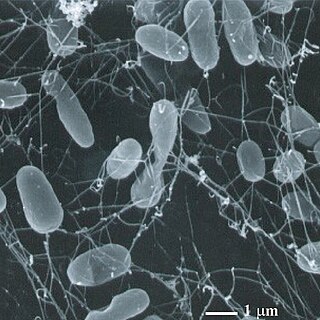Related Research Articles

Pseudomonas is a genus of Gram-negative, Gammaproteobacteria, belonging to the family Pseudomonadaceae and containing 191 validly described species. The members of the genus demonstrate a great deal of metabolic diversity and consequently are able to colonize a wide range of niches. Their ease of culture in vitro and availability of an increasing number of Pseudomonas strain genome sequences has made the genus an excellent focus for scientific research; the best studied species include P. aeruginosa in its role as an opportunistic human pathogen, the plant pathogen P. syringae, the soil bacterium P. putida, and the plant growth-promoting P. fluorescens, P. lini, P. migulae, and P. graminis.
Acetobacter is a genus of acetic acid bacteria. Acetic acid bacteria are characterized by the ability to convert ethanol to acetic acid in the presence of oxygen. Of these, the genus Acetobacter is distinguished by the ability to oxidize lactate and acetate into carbon dioxide and water. Bacteria of the genus Acetobacter have been isolated from industrial vinegar fermentation processes and are frequently used as fermentation starter cultures.

Enterobacter is a genus of common Gram-negative, facultatively anaerobic, rod-shaped, non-spore-forming bacteria of the family Enterobacteriaceae. It is the type genus of the order Enterobacterales. Several strains of these bacteria are pathogenic and cause opportunistic infections in immunocompromised hosts and in those who are on mechanical ventilation. The urinary and respiratory tracts are the most common sites of infection. The genus Enterobacter is a member of the coliform group of bacteria. It does not belong to the fecal coliforms group of bacteria, unlike Escherichia coli, because it is incapable of growth at 44.5 °C in the presence of bile salts. Some of them show quorum sensing properties.
Mycobacterium botniense is a slowly growing Mycobacterium, which produces a yellow pigment. It was first isolated from a stream of water. M. botniense is most closely related to Mycobacterium xenopi. Etymology: botniense; of Botnia, referring to the Latin name of the province of Finland from which the isolation was made.
Mycobacterium kubicae is a Gram-positive, nonmotile and acid-fast bacterial species. Cells are typically rod-shaped, with some coccoid forms. Colonies of M. kubicae on solid media are generally smooth and domed, with a yellow scotochromogenic pigment. On Löwenstein-Jensen media they appear film-like. This species is not known to be pathogenic to humans. The species is named after American mycobacteriologist George Kubica.
Mycobacterium kumamotonense
Etymology: kumamotonense, pertaining to Kumamoto Prefecture in Japan, where the type strain was isolated.
Aggregatibacter actinomycetemcomitans is a Gram-negative, facultative anaerobe, nonmotile bacterium that is often found in association with localized aggressive periodontitis, a severe infection of the periodontium. It is also suspected to be involved in chronic periodontitis. Less frequently, A. actinomycetemcomitans is associated with nonoral infections such as endocarditis. Its role in aggressive periodontitis was first discovered by Danish-born periodontist Jørgen Slots, a professor of dentistry and microbiology at the University of Southern California School of Dentistry.

Pyrolobus fumarii is a species of archaea known for its ability to live at extremely high temperatures that kill most organisms.
Escherichia coli O104:H4 is an enteroaggregative Escherichia coli strain of the bacterium Escherichia coli, and the cause of the 2011 Escherichia coli O104:H4 outbreak. The "O" in the serological classification identifies the cell wall lipopolysaccharide antigen, and the "H" identifies the flagella antigen.
Pedobacter nyackensis is a species of Gram-negative, rod-shaped, non-spore-forming eubacterial species. Its type strain is.
Halomonas hamiltonii is a halophilic bacteria first isolated from the environment surrounding dialysis patients. It is closely related to H. magadiensis.
Kaistia dalseonensis is a bacterium from the genus of Kaistia which has been isolated from river sediments from the Dalseo Stream in Korea.
Kaistia defluvii is a Gram-negative, aerobic and non-motile bacterium from the genus of Kaistia which has been isolated from river sediments from the River Geumho in Korea.
Kaistia geumhonensis is a bacterium from the genus of Kaistia which has been isolated from river sediments from the Geumho River in Korea.
Kaistia granuli is a Gram-negative, chemoorganotrophic, non-spore-forming, rod-shaped and non-motile bacterium from the genus of Kaistia which has been isolated from sludge from a wastewater treatment plant in Gongju in Korea.
Kaistia hirudinis is a Gram-negative and rod-shaped bacterium from the genus of Kaistia which has been isolated from a leech from the Leech Breeding Station in Biebertal in Germany.
Kaistia soli is a Gram-negative, strictly aerobic and non-motile bacterium from the genus of Kaistia which has been isolated from a peat layer 1200 meter above sea level in Yongneup in Korea.
Kaistia terrae is a bacterium from the genus of Kaistia which has been isolated from wetland soil from Yongneup in Korea.
Kaistia algarum is a Gram-negative, strictly aerobic and non-motile bacterium from the genus of Kaistia which has been isolated from the alga Paulinella chromatophora.
References
- 1 2 Parte, A.C. "Kaistia". LPSN .
- ↑ "JCM 21486 Strain Passport - StrainInfo". www.straininfo.net.
- ↑ "Kaistia adipata". www.uniprot.org.
- ↑ "Details: DSM-17808". www.dsmz.de.
- ↑ Im, WT; Yokota, A; Kim, MK; Lee, ST (October 2004). "Kaistia adipata gen. nov., sp. nov., a novel alpha-proteobacterium". The Journal of General and Applied Microbiology. 50 (5): 249–54. doi: 10.2323/jgam.50.249 . PMID 15747229.